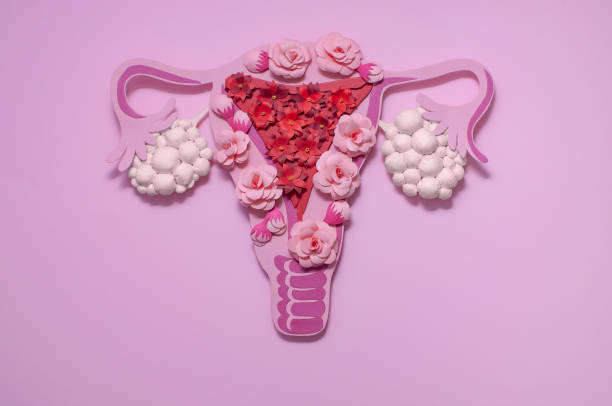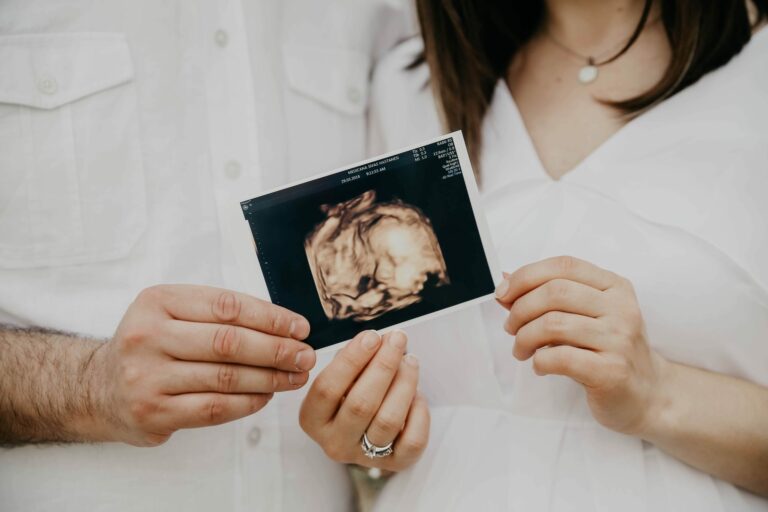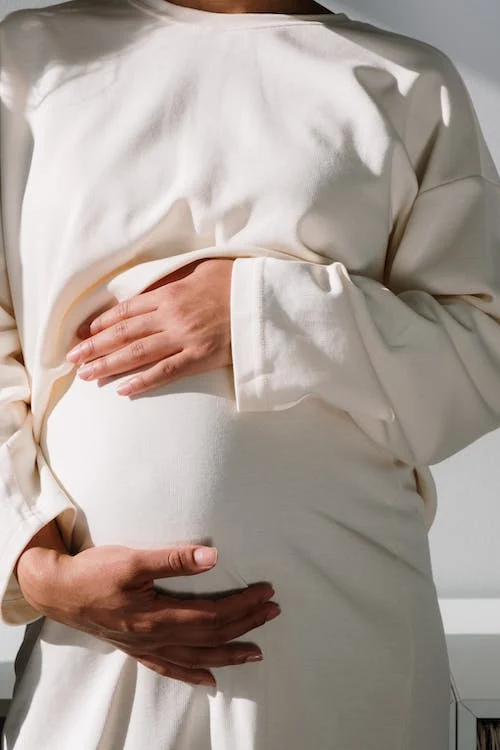Can Ovarian Cysts Cause Infertility?
When there are concerns about infertility, the ovaries are one of the primary causes of concern. Are they intact? Are there undiscovered cysts on the ovaries? If there are cysts, can ovarian cysts cause infertility? It is quite a hassle, so let’s break it down in this post and walk through it.
What are ovarian cysts?
These are common cysts that develop inside ovaries; they are sacs filled with fluids or semifluid-like materials. They may form in one or both of the ovaries. There are different types of ovarian cysts; most are painless and benign (not cancerous) and usually do not cause obvious or noticeable symptoms. However, they may become very large and may not regress on their own, and these may need medical attention.
Types of ovarian cysts
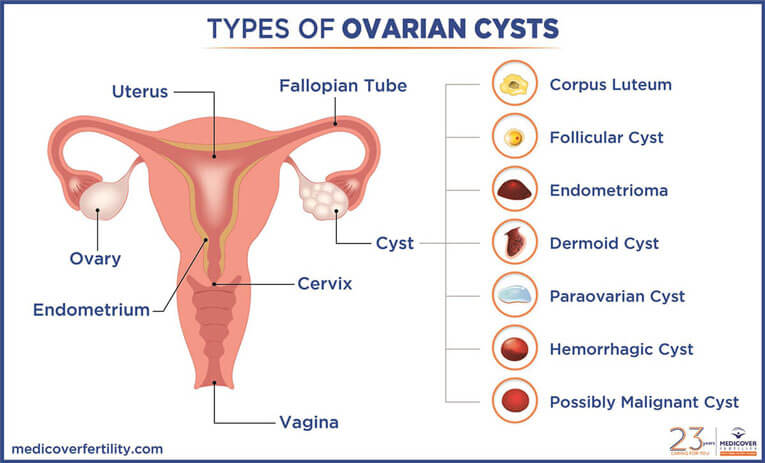
There are different types of cysts; the most common is the functional cyst, which is also called a simple cyst. Other types of cysts include dermoid cysts, endometriomas, ovarian cancer cysts and cystadenomas.
- Functional cysts – They are usually not caused by a disorder or illness and may form as a result of the normal ovulation process, and they generally regress over time (usually within months) without any particular treatment. A functional cyst can form in any of the following structures.
- Follicle – these are referred to as follicular cysts. They form when a follicle does not release an egg and instead fills with fluid and grows larger.
- Corpus luteum – a corpus luteum is formed after a follicle releases an egg. It then forms a hormone-producing collection of cells. A cyst forms when the place the egg is released from gets blocked, and fluid collects and builds up in the corpus luteum.
- Cystadenomas – these types of cysts develop from the cells which cover the outer surface of the ovary. They are of different types, they can be serious cystadenomas which are filled with thin fluid, or they can be mucinous cystadenomas which are filled with a mucous type of fluid. Cystadenomas do not attach directly to the ovary but are usually connected to the ovary by a stalk. Cystadenomas are usually benign, but some can be cancerous.
- Endometriomas – endometriosis happens when the endometrial tissue (tissue that lines the inside of the uterus) is found outside the uterus. Endometriosis can form in one or more ovarian cysts, and they are usually filled with blood. These cysts may also be referred to as chocolate cysts because the blood inside them ages and then turns brown. They are usually benign.
- Dermoid cysts – these types of cysts can grow large (up to 10-15 cm across. They may contain strange and unusual content as they are made up of cells which make eggs in the ovaries. These egg cells have the potential to form different types of body tissue. They may contain hair, teeth, fatty tissue and even skin tissue. They are rarely found in both ovaries and are usually genetically inherited.
Signs of ovarian cysts
Usually, ovarian cysts do not cause any obvious symptoms, but as the cyst grows larger, symptoms may appear. Some of the symptoms may include
- Bloating or swelling of the abdomen
- Painful sexual intercourse
- Vomiting or nausea
- Breast tenderness
- Pelvic pain
- Menstrual pain
- General body pain
Immediate medical help should be sought after if severe symptoms are experienced, and these include
- Fever
- Fainting and dizziness
- Rapid breathing or shortness of breath
- Severe pelvic pain
The above symptoms can indicate a ruptured ovarian cyst or even ovarian torsion, and these are serious conditions with severe medical consequences if not immediately handled.
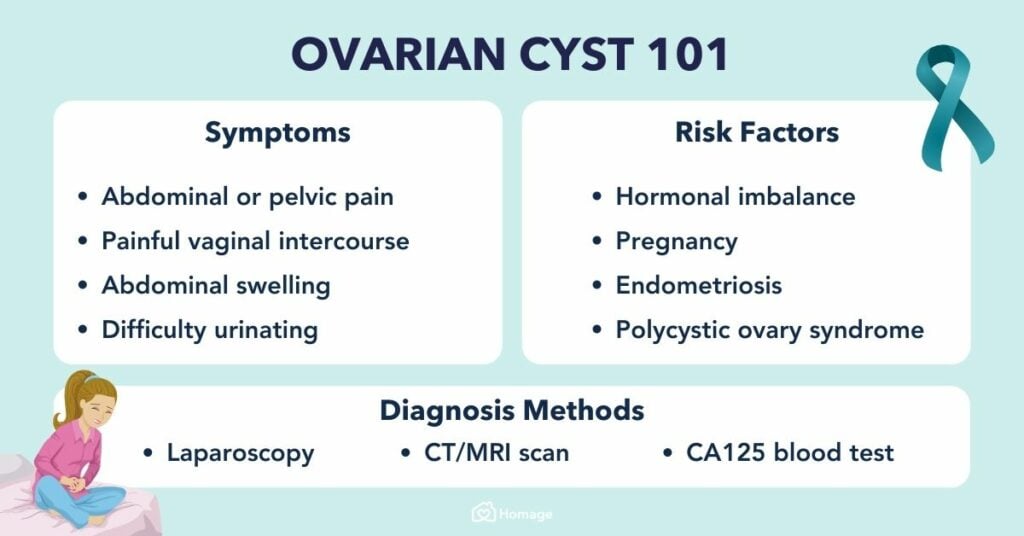
Risk factors
The chances of developing ovarian cysts may be higher with
- Hormonal imbalance
- Pregnancy
- Endometriosis
- Severe pelvic infection
- Previous ovarian cysts
Complications of ovarian cysts
Ovarian cysts are usually benign and resolve on their own over several menstrual cycles. These cysts usually do not cause any symptoms and usually regress without any medical attention. However, some complications may arise from cysts rupturing, getting infected or leading to ovarian torsion.
- Ovarian torsion – this happens when cysts become very large and cause the ovaries to move around. This movement then increases the chances of twisting the ovaries (torsion). When there is ovarian torsion, there is a sudden onset of symptoms, including severe pelvic pain, nausea and vomiting. Ovarian torsion requires immediate medical attention as blood flow to the ovaries may also have been cut off, which could lead to necrosis.
- Rupture – a cyst may burst open (rupture); this can lead to severe pain and bleeding inside the pelvis. Larger cysts are at greater risk of rupturing. Cysts rupture as a result of vigorous activities.
- Infected ovarian cyst – an ovarian cyst may form as a result of pelvic infection, forming an abscess which gets filled with pus. In the event of the rupture of the pus, it may lead to a serious infection (peritonitis).
- Ovarian cysts and infertility – As stated previously, ovarian cysts are formed due to normal body processes and do not usually have any residual consequences. However, there are a few cysts that are associated with lower fertility. Usually, it is not the cyst but the illness or condition that influences the cyst that lowers fertility. Examples include
- Endometriosis – this is an example of an ovarian cyst causing illness which may reduce fertility. Endometriomas are formed as a result of endometriosis. These endometriomas can grow very large and are filled with dark blood. These large cysts can damage the ovaries, lead to adhesions, cause ovarian torsion and may even block the fallopian tubes. Studies have demonstrated that women with even mild cases of endometriosis have only a 2-4% chance of conceiving, compared to the 15-20% chance that healthy women have. Some
- Polycystic ovary syndrome (PCOS) – this condition is usually caused by hormonal imbalance, which leads to many tiny ovarian cysts. This condition affects fertility more than any other condition besides age. In PCOS, the eggs never mature enough to induce ovulation, so none are released from the ovary. The immature follicles containing immature eggs then cause the ovary to become polycystic (filled with tiny cysts). The chronic lack of ovulation then alters the levels of hormones that influence the ovulation process, and this may lead to higher levels of androgens which PCOS is usually associated with.
“Medical Advice Disclaimer:
DISCLAIMER: THIS SITE DOES NOT PROVIDE MEDICAL ADVICE OR OPINION:
The information provided in this article or website by way of text, illustration, graphics, Images or any other form in this article or website is provided for informational purposes only. No information or material provided on this site is meant to be a substitute for a professional medical advice. Please refer to your family doctor or specialist in that field for any medical condition, diagnosis and treatment. Do not delay in contacting a professional on account of something you have read in this article or on this website.”
The information provided in this blog is for educational purposes only and should not be considered as medical advice. It is not intended to replace professional medical consultation, diagnosis, or treatment. Always consult with a qualified healthcare provider before making any decisions regarding your health. Read more

